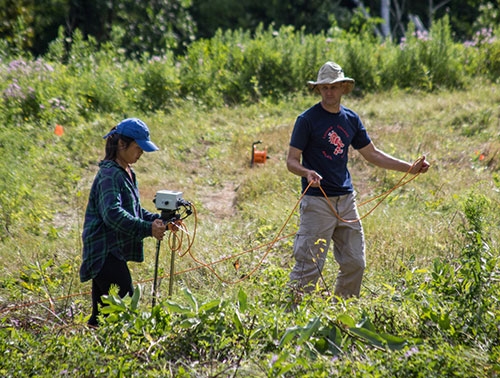You are here
Home ›Luther College professor to lecture on research conducted at Effigy Mounds

Presenting lecture on research at Effigy Mounds ... Luther College Professor Colin Betts (right) works alongside one of his students as they conduct research at Effigy Mounds National Monument. Professor Betts and his students will be presenting a lecture on their research practices and findings this Thursday, October 17 at Luther College in Decorah. Submitted photo.
In recognition of Iowa Archaeology Month and International Archaeology Day, Luther College in Decorah will be presenting a lecture surrounding the ongoing research conducted on Iowa’s effigy mounds by Colin Betts, Luther archaeologist and professor of anthropology, and his students. The lecture will take place at 7 p.m. Thursday, October 17 in Olin Building, room 102 on the Luther College campus. This presentation is open to the public with no charge for admission.
A rich part of northeast Iowa’s cultural heritage and landscape, Effigy Mounds National Monument offers a collection of prehistoric earthen constructions in the shape of animals. Set in Allamakee and Clayton counties, they are rare, geographical elements that carry an air of mystery. Though there has been more than a century worth of research around them, the meaning and purpose of their indigenous architects remain an open case.
Betts and his students are working to look beneath the ground’s surface to enhance understanding of the mounds. To do that, they are using remote sensing techniques, a non-destructive way to survey the sacred architecture.
“Each mound took several days to survey, so the details of each were revealed a little bit at a time. It was really rewarding to have that immediate feedback each day as well as the sense of anticipation in looking ahead to what each day’s data collection would reveal,” said Betts.
The work done on effigy mounds by Luther faculty and students represents one of the first times remote sensing tools have been used to comprehensively study them.
“As a result, we were able to identify previously unknown aspects of the ways in which the mounds were constructed - particularly in the use of different types of soils to create the wings of a bird mound. The mounds involve so much more than just their external shapes, they exhibit an entirely different level of complexity just beneath the surface,” said Betts.
While many unknowns remain, one thing is for certain: participating in this kind of research is an unforgettable opportunity for Betts’ students. “They get to participate in the entirety of the research process - from setting up the site grids to operating the geophysical instruments and ultimately analyzing the results and presenting them at an academic conference,” he said.

